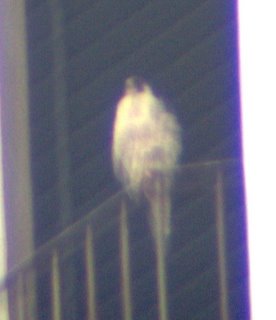and a Black-crowned Night
Heron...............................
Thursday, 11 May 2006

Immature Black-crowned Night Heron at Harlem Meer Photo by Eleanor Tauber
Temperature-62 F
Humidity-79%
Wind variable
Gusts to 15MPH
All times PM unless otherwise noted.
Gapstow Bridge
6:39 Peregrine perched on mid-railing preening, northface GM
Building, midsection, 1. It has distinct white "earmuffs" and is
nearly five slats tall. It is the Mrs.
6:45 She shifts to far west corner of railing, facing east. Wind ruffles her feathers, preens wings. Triangulates, alert, preens breast, focus N.
6:48 Mature Black-crowned Night Heron is preening on Goose Nest Island, the small island of rock, two trees and a circle of greenery, just south of Gapstow.
6:52 Mrs. P. takes off and I loose her.
6:56 She arrives at GM 5 West, facing in, cocks head.
6:57 Head down, she looks out over right shoulder.
7:00 defecates, crouches, then down, inside of railing, disappears.
7:02 The male Peregrine, appears at the bottom of railing GM6 West, drops into the air and out of sight.
7:13 A pair of Canada Geese have their 6 young goslings on the lawn.(Yesterday it was seven, I wonder if the Night Heron skulking in the reeds of Goose Nest Island is the culprit.) The family is on the south bank of The Pond, the section north of Gapstow Bridge. The gander stands tall and alert doing sentinel duty. The goose herds the goslings and eats grass with them. Gander allows sparrows and robins to come close to the young but when a Grackle strides toward them, he jumps at it and hisses. The Grackle retreats. People get too close and the geese take to the water and come out on the north bank.
7:38 The male falcon flies in from the south, to past GM 5 West then back south. Geese are in the water paddling toward the island. The goose and gander are horizontal to each other with the goslings closely massed between them as they swim.
7:39 Night Heron is standing nearly invisible and completely motionless in the reeds of Goose Nest Island, NW side.
7:44 Goose family come ashore, the SE side. Gander goes to the north side of tree and it's green vegetation circle, goslings into the greenery, goose circles the south side of the tree.
7:50 Goose and Gander looking large and muscular, go closer to the Night Heron. He goes to the NE edge of the island. Goose family go back into the pond following the six goslings. They head to the east shore where a man is eating and look at him expectantly.
7:53 Goose family returns to island, where Night Heron is back being motionless in the reeds. Gander goes closer to Heron, suddenly does a quick jump at him. Night Heron is startled out of the reeds and goes to far E tip of island.
7:54 Goose and Gander fence goslings into the green area by the tree.
8:11 Goose is sitting the depression on the island where she previously sat her eggs. The goslings crowd under her. Gander stands alert and vigilant.
8:15 Duckling calls sound. I'd been told earlier that a Mallard Hen had been killed and her ducklings orphaned. Two remained. We pack up quickly and go towards the sound on the east bank of The Pond. We see them. They are very, very young. They make it into the water, quacking, and swim away where they can't be followed. More people are needed to catch these guys and get them to the rehabber.
Ducklings this young not only need protection from predators but their waterproofing oil glands haven't begun to function yet. They would normally get the oil for their feathers that keeps them from becoming waterlogged from contact with their mother.



